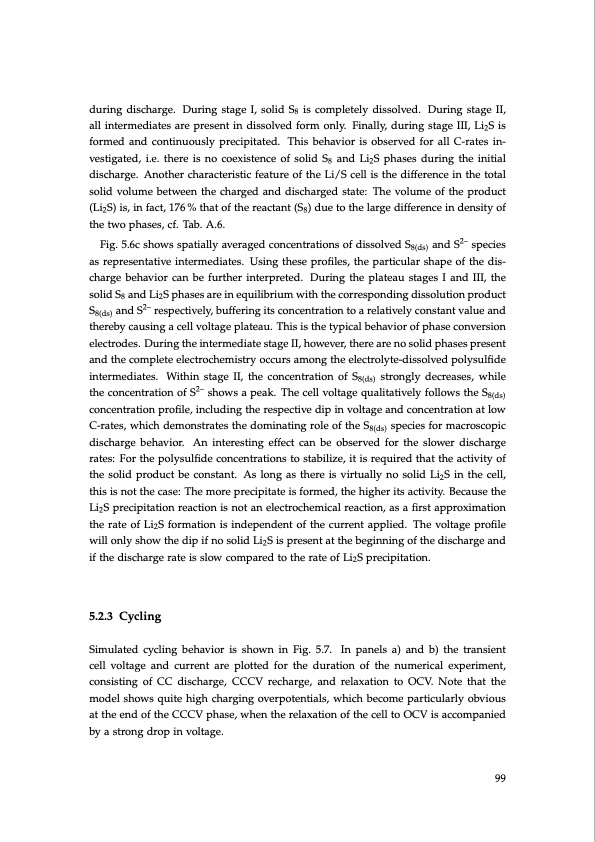
PDF Publication Title:
Text from PDF Page: 099
during discharge. During stage I, solid S8 is completely dissolved. During stage II, all intermediates are present in dissolved form only. Finally, during stage III, Li2S is formed and continuously precipitated. This behavior is observed for all C-rates in- vestigated, i.e. there is no coexistence of solid S8 and Li2S phases during the initial discharge. Another characteristic feature of the Li/S cell is the difference in the total solid volume between the charged and discharged state: The volume of the product (Li2S) is, in fact, 176 % that of the reactant (S8) due to the large difference in density of the two phases, cf. Tab. A.6. Fig. 5.6c shows spatially averaged concentrations of dissolved S8(ds) and S2– species as representative intermediates. Using these profiles, the particular shape of the dis- charge behavior can be further interpreted. During the plateau stages I and III, the solid S8 and Li2S phases are in equilibrium with the corresponding dissolution product S8(ds) and S2– respectively, buffering its concentration to a relatively constant value and thereby causing a cell voltage plateau. This is the typical behavior of phase conversion electrodes. During the intermediate stage II, however, there are no solid phases present and the complete electrochemistry occurs among the electrolyte-dissolved polysulfide intermediates. Within stage II, the concentration of S8(ds) strongly decreases, while the concentration of S2– shows a peak. The cell voltage qualitatively follows the S8(ds) concentration profile, including the respective dip in voltage and concentration at low C-rates, which demonstrates the dominating role of the S8(ds) species for macroscopic discharge behavior. An interesting effect can be observed for the slower discharge rates: For the polysulfide concentrations to stabilize, it is required that the activity of the solid product be constant. As long as there is virtually no solid Li2S in the cell, this is not the case: The more precipitate is formed, the higher its activity. Because the Li2S precipitation reaction is not an electrochemical reaction, as a first approximation the rate of Li2S formation is independent of the current applied. The voltage profile will only show the dip if no solid Li2S is present at the beginning of the discharge and if the discharge rate is slow compared to the rate of Li2S precipitation. 5.2.3 Cycling Simulated cycling behavior is shown in Fig. 5.7. In panels a) and b) the transient cell voltage and current are plotted for the duration of the numerical experiment, consisting of CC discharge, CCCV recharge, and relaxation to OCV. Note that the model shows quite high charging overpotentials, which become particularly obvious at the end of the CCCV phase, when the relaxation of the cell to OCV is accompanied by a strong drop in voltage. 99PDF Image | Lithium-Sulfur Battery: Design, Characterization, and Physically-based Modeling

PDF Search Title:
Lithium-Sulfur Battery: Design, Characterization, and Physically-based ModelingOriginal File Name Searched:
Dissertation_David_N._Fronczek_The_Lithium_Sulfur_Battery.pdfDIY PDF Search: Google It | Yahoo | Bing
Sulfur Deposition on Carbon Nanofibers using Supercritical CO2 Sulfur Deposition on Carbon Nanofibers using Supercritical CO2. Gamma sulfur also known as mother of pearl sulfur and nacreous sulfur... More Info
CO2 Organic Rankine Cycle Experimenter Platform The supercritical CO2 phase change system is both a heat pump and organic rankine cycle which can be used for those purposes and as a supercritical extractor for advanced subcritical and supercritical extraction technology. Uses include producing nanoparticles, precious metal CO2 extraction, lithium battery recycling, and other applications... More Info
| CONTACT TEL: 608-238-6001 Email: greg@infinityturbine.com | RSS | AMP |